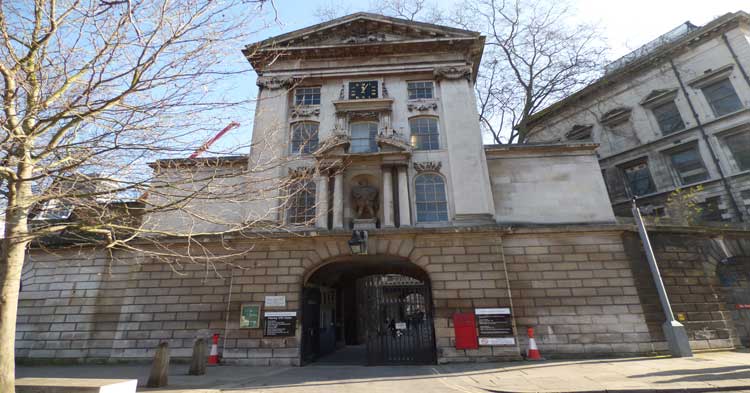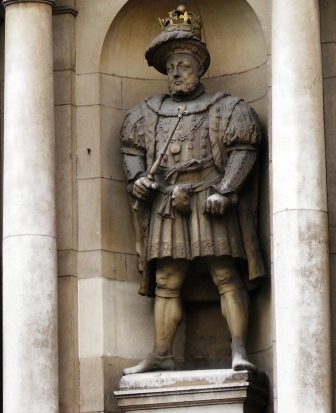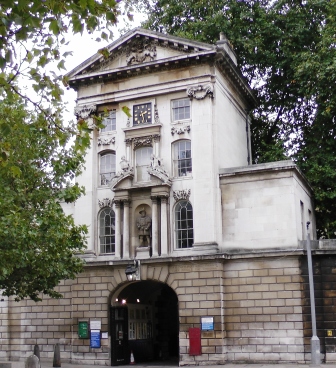
Henry VIII's is not a name that you would readily associate with healing the sick and saving lives. Indeed, quite the opposite is likely to be your first thought when you think of the six times married monarch, whose contribution to surgical science consisted, in most people's minds, of the separating heads from their bodies variety.

Yet, it is to Henry that London owes the survival of its oldest hospital, the hospital of St Bartholomew, or Bart's as it has been affectionately known to generations of Londoners.
Founded in 1123 - along with the long vanished Priory of St Bartholomew and the, still standing, nearby church of St Bartholomew the Great - the hospital developed a good reputation for, if not always actually curing the sick, then certainly for making their afflictions that little bit more bearable.
Patients were nursed, given rest and comfort, plus a reasonable amount of food, together with a goodly amount of ale, and, if, or when, a patient was discharged, they would be sent on their way with a nice pair of new shoes that had been crafted in the monastery's own tannery.
And then, in 1534, Henry VIII went and almost ruined it all by declaring himself Supreme Head of the Church in England and setting in motion the Dissolution of the Monasteries.
The Priory of St Bartholomew was suppressed in 1539, and the hospital would, no doubt, have followed suit had not the City fathers panicked at the prospect of all the poor that the hospital had succeeded in keeping hidden from their view over the preceding centuries, suddenly becoming an all to visible fixture of everyday City of London life.
Thus, they petitioned Henry, asking that he grant the hospital back to the City on account of the fact it was urgently needed to help "the myserable people lyeng in the streete, offendyng every clene person passyng by the way with theyre fylthye and nastye savors."
It took a bit more appealing to Henry's, extremely well hidden, caring and considerate side, not to mention a few false starts, before, on 27th December 1546, he finally granted the "Hospital formally known as St Bartholomew's" to the City of London. However, he was most insistent that the name be changed to the far catchier "House of the Poore in West Smithfield in the suburbs of the City of London, of King Henry VIII's foundation."
Officially speaking, this remained the hospital's actual name until 1948, although generations of Londoners chose to ignore such a grandiose sounding title in favour of just plain Bart's!
Still, Henry had done right by the hospital, so the hospital felt duty bound to do right by Henry, albeit it took them almost two hundred years to show their appreciation.

In 1701, the hospital's governors decided that the north gate should be rebuilt and, in 1702, they agreed to pay John Strong, Junior Mason - and a member of the Strong family of Masons who, at the time, were labouring away at rebuilding nearby St Paul's Cathedral with Sir Christopher Wren - the princely sum of £550 to erect for them a splendid new gatehouse.
And, over the arch, they placed a statue of Henry VIII the despotic King who, for all his faults, was responsible for ensuring that the hospital survived his break with Rome and could continue to administer to the sick of London.
It has performed its service to generations of Londoners ever since, and is still going strong.
This magnificent gatehouse, is still the main entrance of the hospital, and through it pass patients, staff and visitors alike, day in and day out, just as they have done for over 300 years.
How many of them ever stop to admire its exquisite ornamentation, or to consider the fact that such a rich and graceful structure, that would not be out of place at the threshold of a palace or stately home, was, in fact, built as the entrance from the street to a hospital for the poor?
How many of those who pass through it ever notice the proud and regal figure, resplendent with his decidedly exaggerating codpiece, that gazes out across Smithfield from his lofty perch between four round columns, and consider the fact that they are looking at the only outdoor statue of King Henry The Eighth in the whole of London?
But they are, and it is, and that's all!